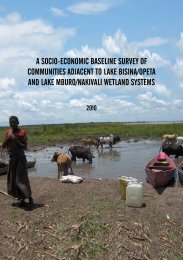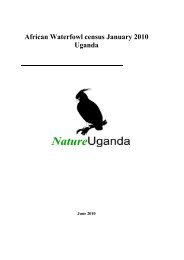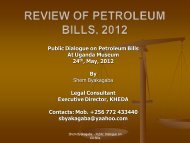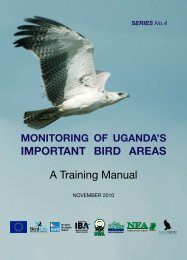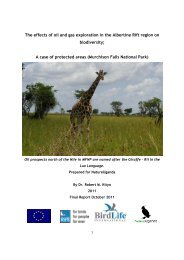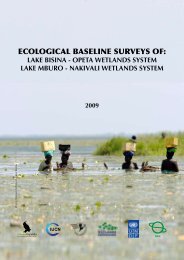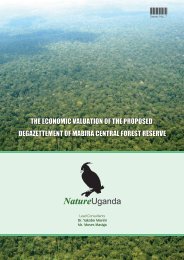Status and Trends 2009 - Nature Uganda
Status and Trends 2009 - Nature Uganda
Status and Trends 2009 - Nature Uganda
You also want an ePaper? Increase the reach of your titles
YUMPU automatically turns print PDFs into web optimized ePapers that Google loves.
Disturbance to birds<br />
The disturbance to birds has been reported from 16%, (n=5 )<br />
of the IBAs. In Nyamuriro wetl<strong>and</strong> <strong>and</strong> Doho Rice Scheme, the<br />
people who are working in the field are the source of disturbance,<br />
in Mabamba Bay, it is the fishing communities who use the same<br />
tracts as the shoebill trekkers <strong>and</strong> who are potential sources of<br />
disturbance. This trend is similar to Semliki WR <strong>and</strong> Musambwa<br />
Isl<strong>and</strong> fishing communities who sometimes construct makeshift<br />
structures within the IBAs.<br />
Drainage<br />
Deliberate filling or conversion of wetl<strong>and</strong>s to agricultural fields<br />
is not new. This has been reported at 19% of the IBAs. The<br />
wetl<strong>and</strong>s, where they exist, are seen as soil banks <strong>and</strong> options<br />
for increasing production even in times of no rain. Draining is<br />
being done in Nyamuriro wetl<strong>and</strong>, Lutembe Bay <strong>and</strong> Doho Rice<br />
Scheme. Other areas reported include Nabugabo <strong>and</strong> Nabajjuzi<br />
wetl<strong>and</strong>s.<br />
Small holder grazing or forest grazing<br />
Pastoral communities around IBAs are sometimes forced by<br />
either adverse weather conditions or encroach of inside or at<br />
the boundaries of the IBAs to access better pastures. This is<br />
happening in 68% (n=21) of the IBAs. Sites affected by this type of<br />
threat <strong>and</strong> respective communities include Mt Elgon NP (Bukwo),<br />
Budongo (Lake Albert), MFNP (Bulisa), Nabugabo (Grassl<strong>and</strong>),<br />
Semliki WR (Ntooroko), Semliki NP (Grassl<strong>and</strong>), Mt Mororo FR<br />
(Hill slopes), Sango Bay (Grassl<strong>and</strong>). Other communities include<br />
the Toposa, Didinga <strong>and</strong> Dodoth in Kidepo Valley National Park.<br />
Deforestation<br />
This has been reported at 26% (n=8) of the IBA. The ever growing<br />
dem<strong>and</strong> for construction materials is promoting illegal logging<br />
thus affecting the quality of IBA condition. Most of the timber<br />
products <strong>and</strong> round wood products (e.g. poles) are obtained from<br />
Forest Reserves <strong>and</strong> sometimes National Parks. It is worth noting<br />
that some of the extractions are done with the knowledge of the<br />
relevant management authority under controlled use quotas or<br />
production regimes. Examples of this can be seen in Mt Elgon NP,<br />
Mt Kei FR, <strong>and</strong> the shores of Lutembe Bay, Semliki WR, Semliki<br />
NP <strong>and</strong> Sango Bay. Extensive or intensive logging has not been<br />
reported.<br />
Colonization<br />
Succession can be a natural event or induced by disturbance<br />
from human activities in or around the IBAs. The change of<br />
conditions within the habitat may favour the emergence of species<br />
which may later on alter the ecology <strong>and</strong> the eventual species<br />
composition of the site. This is evident at 13% (n=4) of the 33<br />
IBAs. The most notable is Lutembe Bay which has experienced<br />
many threats around it <strong>and</strong> all contributing to a change of habitat<br />
type with marshes dwindling <strong>and</strong> papyrus areas becoming more<br />
pronounced.<br />
Firewood collection / Charcoal burning<br />
The country’s population is one that depends on fuel wood energy<br />
resources <strong>and</strong> most of these resources are derived from nature.<br />
The wood energy if restricted to dry wood harvests. Sometimes<br />
controlled use quotas ensure sustainability. Fuel wood collection<br />
has been reported from 71% (n=22) of the IBAs. Notable<br />
amongst others are the communities of Mt Elgon NP, Budongo,<br />
Kyambura, MFNP, LMNP, Semliki NP, Semliki WR, Mt. Moroto<br />
FR <strong>and</strong> Sango Bay that are dependent on this wood fuel energy<br />
source.<br />
<br />
Human Settlement, Infrastructure <strong>and</strong> Real estate<br />
development,<br />
The population increase <strong>and</strong> the concomitant dem<strong>and</strong><br />
for l<strong>and</strong> have made the IBAs <strong>and</strong> other biodiversity rich<br />
areas targets for human settlement. There are cases of<br />
encroachment for settlement in Mt Elgon NP, Real estate<br />
development in Lutembe Bay, road construction <strong>and</strong><br />
power line construction in Semliki NP, town extension <strong>and</strong><br />
settlement in Mt. Moroto FR, Sango Bay, <strong>and</strong> Musambwa<br />
Isl<strong>and</strong>. Overall, this type of threat was reported at 19%<br />
(n=6) of the IBAs. It should be noted that some of the<br />
settlements are done on the edges of the IBAs but also<br />
inside the boundaries. There is therefore need to demarcate<br />
IBA boundaries where this has not been done so that it is<br />
easier to track encroachment within IBAs.<br />
Natural events (l<strong>and</strong>slides, floods <strong>and</strong> drought)<br />
Natural events come in the form of l<strong>and</strong>slides, floods <strong>and</strong><br />
drought. The mountainous areas of the country have been<br />
mostly affected by l<strong>and</strong>slides. The high inclines of the Mt<br />
Elgon NP <strong>and</strong> Rwenzori NP coupled with heavy rains have<br />
resulted in a series of l<strong>and</strong>slides. The North Eastern part<br />
of the country especially Mt Moroto FR has experienced<br />
enduring stress from drought <strong>and</strong> drought related events<br />
such as fires. The eastern part of the country experienced<br />
heavy rains resulting into floods especially in parts of<br />
Butaleja where Doho rice scheme was under water. Overall,<br />
this type of threat occurred in 13% (n=4) of the IBAs that<br />
were monitored.<br />
Recreation / tourism<br />
Tourism is one of the sustainable use options in conservation<br />
however, new developments need to be checked <strong>and</strong> all<br />
the precautions taken. The threat is reported from 29%<br />
(n=9) of the IBAs in Ug<strong>and</strong>a. There are new tourism<br />
developments in Mt Elgon NP, eco-lodges in Budongo FR,<br />
renovation of Lutembe beach, popularization of Nabugabo<br />
beach <strong>and</strong> camp, Mabamba shoebill watching <strong>and</strong> Semliki<br />
NP hot springs. These all risk potential sources of threats<br />
if not controlled. Controlled development of tourist facilities<br />
as well as ensuring these facilities meet the environmental<br />
st<strong>and</strong>ards through the m<strong>and</strong>atory environmental impact<br />
assessments <strong>and</strong> mitigation measures outlined.<br />
Unsustainable utilization of resource<br />
The use of biological resources is one of the main reasons<br />
why the IBA adjacent communities should be involved in the<br />
conservation process of the sites. The resources that are<br />
of notable values are bamboo shoots in Mt Elgon NP, fuel<br />
wood in Mt Kei, timber <strong>and</strong> non timber forest materials in<br />
Budongo FR, fuel wood in Kyambura, MFNP <strong>and</strong> LMNP.<br />
Wetl<strong>and</strong> resources in Lutembe, Nabugabo, Nyamuriro<br />
<strong>and</strong> Mabamba, while rattan cane harvest in Semliki NP<br />
<strong>and</strong> fodder in Semliki WR <strong>and</strong> Mt. Moroto FR respectively.<br />
The resource utilization is the most reported covering 90%<br />
(n=28) of the IBAs. Some uses are however, sustainable <strong>and</strong><br />
are controlled by the management authorities. However, a<br />
major problem is when the agreed use regulations are not<br />
adhered to or the managing authorizes lack the capacity to<br />
effectively enforce <strong>and</strong> monitor the levels of use.<br />
Extractive industry<br />
Extractive industry is reported from 26% (n=8) of the<br />
IBAs. There are different forms of extractive industries



